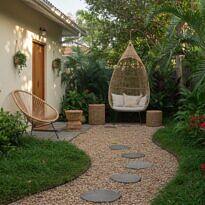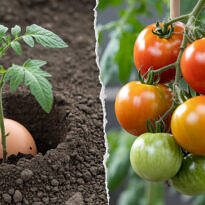
Beaches are naturally beautiful, and we can bring the beauty of this nature to our garden in a harmonious and sustainable way. But how?
Many individuals might think that creating and maintaining a garden at a beach house is challenging. Indeed, since we spend most of the year away from the coastline, the garden often remains neglected during this time.
Likewise, we don’t want to spend our vacation time gardening; on the contrary, we’re more inclined to admire nature and enjoy the flowers and fruits it provides.
Apart from being neglected throughout the year, the garden is exposed to typical coastal climate adversities. These include high summer temperatures, constant rain, wind, and salt spray, sandy and excessively saline soils, and even cold temperatures during winter.
All of these details need to be considered when planning a garden that should also feature flowers or fruits during the summer and require low maintenance. After all, there’s no point in planting a beautiful flower adapted to the coastal environment if it only blooms in winter when we’re not there to admire it.

Designing a seaside garden demands more from the landscaper, as beyond the factors listed above, the landscape must be harmonious and not clash with the natural beauty of the shoreline. It’s like conducting a complex orchestra that needs careful guidance to ensure everything works out and the residents are pleased.
A golden rule in such cases: closely observe the plants that naturally occur in the area; they are adapted and equipped to withstand adversities, given that the coastal landscape in one region may differ from another.
Another crucial consideration is the terrain. Low-lying land can be invaded by high tides, which can damage the garden. If your property is seaside, elevating it slightly can be a solution to prevent this issue.
Most landscapers opt for tropical gardens to adorn coastal constructions. The plants in these gardens are the most suited to withstand the elements and blend well with the beach landscape. Alternatively, Mediterranean or contemporary style gardens can also be executed without issues.
It’s important for the plants not to obstruct the view of the sea; on the contrary, they should enhance and frame it harmoniously.
After proper analysis, the soil should be corrected in terms of pH and nutrients, so it can accommodate the new plants. Typically, due to their sandiness, they need to be conditioned with clay-rich soil and ample organic matter. Spare no effort or expense during this phase, as properly prepared soil can prevent future headaches; this step is challenging to rectify after the garden’s implementation.

Furniture and accessories are equally significant and should be ultra-resistant. One of the more economical and durable choices is polypropylene. The material is lightweight and washable, and some manufacturers even treat the furniture with a special resin that guards against UV radiation.
For more sophisticated options, use resilient woods like teak, which requires little maintenance and should always be protected with marine varnish. Steer clear of metals, as they rust with salt spray. Even stainless steel should only be used if adequately protected. Stay away from natural fibers like reed or rattan; nowadays, synthetic materials are available as substitutes.
Finally, don’t forget that you wouldn’t want to spend your summer toiling away in the garden. Use your creativity and knowledge to craft your private paradise—a place for rest and contemplation. Note: Reserve a special spot for a hammock or chaise lounge to admire the sea view.
Plant Tips:
- Lawns and Ground Covers:
- Emerald Zoysia Grass (Zoysia japonica)
- St. Augustine Grass (Axonopus compressus)
- St. Augustine Grass (Stenotaphrum secundatum)
- Wedelia (Sphagneticola trilobata)
- Trees and Palms:
- Climbing Plants:
- Bougainvillea (Boungainvillea spectabilis)
- Wisteria (Wisteria floribunda)
- Shrubs:
- Hibiscus (Hibiscus rosa-sinensis)
- Oleander (Nerium oleander)
- Clusia (Clusia fluminensis)
- Allamanda Shrub (Allamanda laevis)
- Yucca (Yucca elephantipes)
- Ixora (Ixora coccinea)
And now, for you to get inspired, discover some specific features of landscaping in some of the world’s most famous beaches.
1. Florida:
In the sunny state of Florida, coastal landscaping takes on a unique character due to its tropical climate. The warm temperatures and occasional storms pose challenges for plant selection. Palms like Coconut Palms and Sabal Palms thrive here, while colorful flowering plants such as Bougainvillea and Hibiscus add vibrancy to the landscape. Dune restoration and salt-tolerant grasses like Sea Oats are crucial for stabilizing the sandy soil and preventing erosion along the coastline.
Miami, located on the southern tip of Florida, showcases lush and tropical coastal landscaping. Palm trees, such as Royal Palms and Foxtail Palms, create a signature look. Bromeliads, Crotons, and other colorful foliage plants thrive in the subtropical climate. Water features and poolside gardens are popular additions to Miami’s coastal landscapes.
2. California:
California’s coastal landscaping is marked by its diverse microclimates. From the foggy coasts of San Francisco to the sunny beaches of San Diego, native plants like California Poppy and Coast Live Oak are staples. Succulents like Agave and Aloe are popular for their water efficiency. Drought-resistant landscaping is a priority in California, with Mediterranean-style gardens often featuring drought-tolerant plants and gravel pathways.
Malibu, California, is famous for its celebrity homes and stunning coastline. Coastal landscaping here embraces a relaxed, beachy vibe. Native plants like California Lilac and California Fuchsia add pops of color. Native grasses and succulents are often used for their low-water requirements, fitting the region’s water-conscious culture.
3. Hawaii:
In the tropical paradise of Hawaii, coastal landscaping is a blend of native flora and exotic plants. Unique volcanic soils and abundant rainfall create a lush environment. Plants like Plumeria, Bird of Paradise, and Hawaiian Ti flourish here. Tiki torches and lava rock elements enhance the island feel of the landscape. However, attention must be paid to invasive species to protect the delicate ecosystems.
4. Brighton:
The coastal landscape of Brighton, UK, presents challenges due to its cold and windy climate. Hardy plants like Sea Thrift, Beach Grass, and Lavender are common choices. Coastal protection measures, such as windbreaks and salt-tolerant hedges, are crucial to safeguard the garden from the harsh elements. Coastal gardens here often exude a charming and rugged character.
5. Camber Sands:
Camber Sands, also in the UK, boasts picturesque dunes and sandy shores. The landscape is characterized by Marram Grass, Sea Holly, and Sea Buckthorn, which are adapted to the coastal environment. These plants play a vital role in stabilizing the dunes and preventing erosion. Sustainable practices, such as avoiding trampling on delicate dune ecosystems, are essential for maintaining the area’s natural beauty.
6. Auckland:
In Auckland, New Zealand, coastal landscaping reflects the diverse range of plants native to the region. Flax, Pohutukawa trees (known as New Zealand Christmas trees), and various ferns are common choices. Māori cultural influences often emphasize the connection between land and sea. Rain gardens and permeable surfaces contribute to water management in this coastal city.
7. Sydney:

Coastal landscaping in Sydney, Australia, is characterized by a mix of native plants like Kangaroo Paw and Banksia, along with exotic species that have adapted to the local climate. Sydney’s varied microclimates allow for a wide range of plant choices. Coastal gardens often feature outdoor living spaces that take advantage of the stunning ocean views.
8. Gold Coast:
Australia’s Gold Coast is known for its golden beaches and subtropical climate. Coastal landscaping here often features tropical and subtropical plants like Frangipani, Grevillea, and Cordyline. The beach lifestyle is seamlessly integrated with outdoor entertaining areas and saltwater pools, making it a paradise for both residents and visitors.
Each of these coastal cities, states, and countries presents its unique challenges and opportunities when it comes to landscaping by the sea. Adapting to the local climate, preserving native ecosystems, and creating a harmonious connection between the built environment and the natural beauty of the coast are key considerations for successful coastal landscaping.






